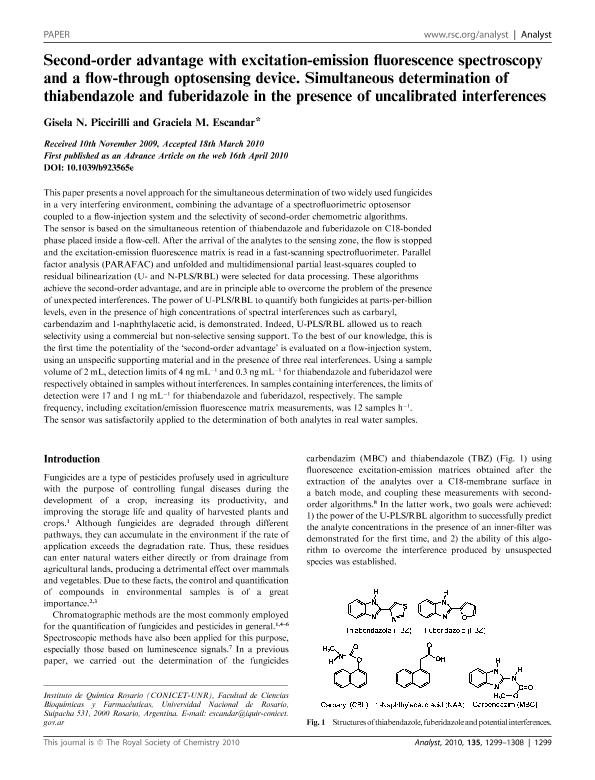Mostrar el registro sencillo del ítem
dc.contributor.author
Piccirilli, Gisela Noemi

dc.contributor.author
Escandar, Graciela Monica

dc.date.available
2021-04-07T13:41:43Z
dc.date.issued
2010-04
dc.identifier.citation
Piccirilli, Gisela Noemi; Escandar, Graciela Monica; Second-order advantage with excitation-emission fluorescence spectroscopy and a flow-through optosensing device: Simultaneous determination of thiabendazole and fuberidazole in the presence of uncalibrated interferences; Royal Society of Chemistry; Analyst; 135; 6; 4-2010; 1299-1308
dc.identifier.issn
0003-2654
dc.identifier.uri
http://hdl.handle.net/11336/129513
dc.description.abstract
This paper presents a novel approach for the simultaneous determination of two widely used fungicides in a very interfering environment, combining the advantage of a spectrofluorimetric optosensor coupled to a flow-injection system and the selectivity of second-order chemometric algorithms. The sensor is based on the simultaneous retention of thiabendazole and fuberidazole on C18-bonded phase placed inside a flow-cell. After the arrival of the analytes to the sensing zone, the flow is stopped and the excitation-emission fluorescence matrix is read in a fast-scanning spectrofluorimeter. Parallel factor analysis (PARAFAC) and unfolded and multidimensional partial least-squares coupled to residual bilinearization (U- and N-PLS/RBL) were selected for data processing. These algorithms achieve the second-order advantage, and are in principle able to overcome the problem of the presence of unexpected interferences. The power of U-PLS/RBL to quantify both fungicides at parts-per-billion levels, even in the presence of high concentrations of spectral interferences such as carbaryl, carbendazim and 1-naphthylacetic acid, is demonstrated. Indeed, U-PLS/RBL allowed us to reach selectivity using a commercial but non-selective sensing support. To the best of our knowledge, this is the first time the potentiality of the 'second-order advantage' is evaluated on a flow-injection system, using an unspecific supporting material and in the presence of three real interferences. Using a sample volume of 2 mL, detection limits of 4 ng mL -1 and 0.3 ng mL-1 for thiabendazole and fuberidazol were respectively obtained in samples without interferences. In samples containing interferences, the limits of detection were 17 and 1 ng mL-1 for thiabendazole and fuberidazol, respectively. The sample frequency, including excitation/emission fluorescence matrix measurements, was 12 samples h -1. The sensor was satisfactorily applied to the determination of both analytes in real water samples.
dc.format
application/pdf
dc.language.iso
eng
dc.publisher
Royal Society of Chemistry

dc.rights
info:eu-repo/semantics/openAccess
dc.rights.uri
https://creativecommons.org/licenses/by-nc-sa/2.5/ar/
dc.subject
SECOND-ORDER
dc.subject
FLUORESCENCE
dc.subject.classification
Química Analítica

dc.subject.classification
Ciencias Químicas

dc.subject.classification
CIENCIAS NATURALES Y EXACTAS

dc.title
Second-order advantage with excitation-emission fluorescence spectroscopy and a flow-through optosensing device: Simultaneous determination of thiabendazole and fuberidazole in the presence of uncalibrated interferences
dc.type
info:eu-repo/semantics/article
dc.type
info:ar-repo/semantics/artículo
dc.type
info:eu-repo/semantics/publishedVersion
dc.date.updated
2021-02-18T15:22:23Z
dc.journal.volume
135
dc.journal.number
6
dc.journal.pagination
1299-1308
dc.journal.pais
Reino Unido

dc.journal.ciudad
Cambridge
dc.description.fil
Fil: Piccirilli, Gisela Noemi. Consejo Nacional de Investigaciones Científicas y Técnicas. Centro Científico Tecnológico Conicet - Rosario. Instituto de Química Rosario. Universidad Nacional de Rosario. Facultad de Ciencias Bioquímicas y Farmacéuticas. Instituto de Química Rosario; Argentina
dc.description.fil
Fil: Escandar, Graciela Monica. Consejo Nacional de Investigaciones Científicas y Técnicas. Centro Científico Tecnológico Conicet - Rosario. Instituto de Química Rosario. Universidad Nacional de Rosario. Facultad de Ciencias Bioquímicas y Farmacéuticas. Instituto de Química Rosario; Argentina
dc.journal.title
Analyst

dc.relation.alternativeid
info:eu-repo/semantics/altIdentifier/url/https://pubs.rsc.org/en/content/articlelanding/2010/an/b923565e/unauth#!divAbstract
dc.relation.alternativeid
info:eu-repo/semantics/altIdentifier/doi/http://dx.doi.org/10.1039/B923565E
Archivos asociados
